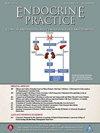糖尿病和脂质:脂质生物标志物和心血管风险的综述和最新进展。
IF 3.7
3区 医学
Q2 ENDOCRINOLOGY & METABOLISM
引用次数: 0
摘要
目的:回顾关于糖尿病和血脂异常之间关系的现有和新的证据,并提供用于评估心血管风险的脂质生物标志物的更新和反映这些变化的现行指南。方法:我们使用MEDLINE/PubMed数据库进行了有关糖尿病和血脂的文献综述。我们回顾了主要发表于1994年至2025年初的英文文章。还包括由国内或国际上在糖尿病、脂质和心血管疾病领域得到认可的专业组织出版的指南。结果:评估糖尿病和高甘油三酯血症之间关系的研究提供了改变实践的证据。脂质标志物,如载脂蛋白B、非高密度脂蛋白胆固醇和脂蛋白(a),以及脂质变异性的概念已成为治疗目标。结论:在过去的30年里,非低密度脂蛋白胆固醇脂质标记物已经被确定,可以进一步对未来心血管事件风险的糖尿病患者进行分层。治疗靶点和药物治疗已被研究并不断更新。本文章由计算机程序翻译,如有差异,请以英文原文为准。
Diabetes and Lipids: A Review and Update on Lipid Biomarkers and Cardiovascular Risk
Objective
To review existing and new evidence regarding the relationship between diabetes and dyslipidemia and to provide an update of the lipid biomarkers used to assess cardiovascular risk and the current guidelines reflecting these changes.
Methods
We conducted a literature review pertaining to diabetes and lipids using the MEDLINE/PubMed database. We reviewed articles in English and primarily published between 1994 and early 2025. Also included are guidelines published by professional organizations who are recognized nationally or internationally in the fields of diabetes, lipids, and cardiovascular disease.
Results
Studies evaluating the relationship between diabetes and hypertriglyceridemia have provided practice-changing evidence. Lipid markers such as apolipoprotein B, non–high-density lipoprotein cholesterol, and lipoprotein (a), as well as the concept of lipid variability have emerged as treatment targets.
Conclusion
Over the past 30 years, non–low-density lipoprotein cholesterol lipid markers have been identified to further stratify individuals with diabetes who are at risk for future cardiovascular events. Treatment targets and pharmacological therapy have been studied and continue to be updated.
求助全文
通过发布文献求助,成功后即可免费获取论文全文。
去求助
来源期刊

Endocrine Practice
ENDOCRINOLOGY & METABOLISM-
CiteScore
7.60
自引率
2.40%
发文量
546
审稿时长
41 days
期刊介绍:
Endocrine Practice (ISSN: 1530-891X), a peer-reviewed journal published twelve times a year, is the official journal of the American Association of Clinical Endocrinologists (AACE). The primary mission of Endocrine Practice is to enhance the health care of patients with endocrine diseases through continuing education of practicing endocrinologists.
 求助内容:
求助内容: 应助结果提醒方式:
应助结果提醒方式:


